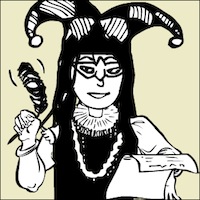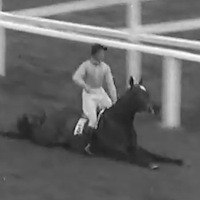Gene Krupa - Father of the Drum Solo

My father played drums for a jazz band for many years. In fact, my dad was in the Army Drum Corps for three years. He was in the Westshoremen Bonny Scots, and he was an amazing drummer. Stick tricks were something that he practiced and perfected about as much as he practiced his paradiddles. His trap set was a beautiful mother-of-pearl set that consisted of two tunable floor toms, two mounted toms, a snare, a bass, hi-hat, 22” ride cymbal, 18” crash cymbal, 16” splash cymbal, and a 10” splash cymbal—and a cowbell. You just got to have a cowbell.
By the time I knew my dad, it was about 1980. That, at least, is when I started becoming cognizant of a man that I referred to as dad. I remember Dad teaching my brother how to hold the sticks—old school style. “Like a spoon in your left hand,” I remember he’d say. As I got older, I started looking through my parents’ old yearbooks. In my dad’s, I saw an interesting epithet. It said, “Alex—you are well on your way to being the next Gene Krupa.” So, I asked him about it. He smiled and he told me about one of the greatest jazz drummers of all time.
 Gene Krupa was the youngest of nine children. He was born January 15, 1909. He had to start working at age 11 to help support the family. His brother got him a job as a chore boy at a local music shop. He got his first drum set at that time—not because he really loved the drums, but because they were the cheapest instrument in the catalogue. He just wanted to play music; it didn’t matter the instrument.
Gene Krupa was the youngest of nine children. He was born January 15, 1909. He had to start working at age 11 to help support the family. His brother got him a job as a chore boy at a local music shop. He got his first drum set at that time—not because he really loved the drums, but because they were the cheapest instrument in the catalogue. He just wanted to play music; it didn’t matter the instrument.
By the time he was in high school, he was already a member of “The Frivolians.” It was during his high school years that he met some of the musicians featured on his first recording. “The Three Deuces” was a popular hang out for many jazz musicians of the time and it was there that Krupa met such people as Tommy Dorsey, Benny Goodman, Mezz Mezzrow, and Bix Beiderbecke, among others.
Krupa became known as the Father of the Drum Solo. Until his time behind the toms, drummers were only present to keep the beat steady. It was Krupa who first began to work with the musicians and branch out into drum solos. It was also Krupa who supported and backed Slingerland to create a new kind of floor tom called “Separate Tension Tunable Tom-Toms.” Before, these toms just had a dead sound, the heads being held in place with nails. With the tunable toms, a tension mechanism tightened the head to give a different sound. Slingerland introduced the tunable toms in 1936, and Krupa endorsed the company until his death.
The Zildjian cymbal company, as well, sought out Krupa for feedback and ideas on the hi-hat. Prior to Krupa’s involvement, the hi-hat was called a “low-boy” and was a floor cymbal played with the foot—which made it very difficult to use sticks on the cymbal. Krupa also made music history in 1927, as the first drummer to record using a bass drum.
Krupa continued his musical pioneering by moving to New York in 1929. It was at this time that he, Glenn Miller, and Benny Goodman played together for Ira Gershwin’s newest musical, Strike Up the Band. A piece of trivia: Gene never learned to read music. He faked the drum parts during rehearsal—Glenn Miller actually hummed the drum line for him until he got it.
Krupa went on to perform with the Goodman Trio and the Goodman Quartet. He had a profitable solo career, but was forced into retirement in 1960, after a heart attack. He came out of retirement in 1970 to record another album. His last public performance was with the Goodman Trio at their reunion. He died October 16, 1973, from a heart attack.
According to my father, there was no better drummer than Gene Krupa. To quote from the source for this article,
To my dad, Gene Krupa was the greatest drummer of all time. To me, that honor belongs to my father. I urge anyone interested in drums to learn more about the opportunities in the music world for drummers. From keeping time to solos, drummers have come into their own as one of the focal points of a band. I also highly recommend looking into DCI. There are junior corps for those in high school and senior corps for those graduated from college and beyond.
For more information, or to view the source article, please visit Gene Krupa’s Biography page. (Image linked from Wikipedia)
Other links of interest from this article:
Army Fife & Drum Corps
Westshoremen
A Rehearsal
Drum Corps International
By the time I knew my dad, it was about 1980. That, at least, is when I started becoming cognizant of a man that I referred to as dad. I remember Dad teaching my brother how to hold the sticks—old school style. “Like a spoon in your left hand,” I remember he’d say. As I got older, I started looking through my parents’ old yearbooks. In my dad’s, I saw an interesting epithet. It said, “Alex—you are well on your way to being the next Gene Krupa.” So, I asked him about it. He smiled and he told me about one of the greatest jazz drummers of all time.
 Gene Krupa was the youngest of nine children. He was born January 15, 1909. He had to start working at age 11 to help support the family. His brother got him a job as a chore boy at a local music shop. He got his first drum set at that time—not because he really loved the drums, but because they were the cheapest instrument in the catalogue. He just wanted to play music; it didn’t matter the instrument.
Gene Krupa was the youngest of nine children. He was born January 15, 1909. He had to start working at age 11 to help support the family. His brother got him a job as a chore boy at a local music shop. He got his first drum set at that time—not because he really loved the drums, but because they were the cheapest instrument in the catalogue. He just wanted to play music; it didn’t matter the instrument.By the time he was in high school, he was already a member of “The Frivolians.” It was during his high school years that he met some of the musicians featured on his first recording. “The Three Deuces” was a popular hang out for many jazz musicians of the time and it was there that Krupa met such people as Tommy Dorsey, Benny Goodman, Mezz Mezzrow, and Bix Beiderbecke, among others.
Krupa became known as the Father of the Drum Solo. Until his time behind the toms, drummers were only present to keep the beat steady. It was Krupa who first began to work with the musicians and branch out into drum solos. It was also Krupa who supported and backed Slingerland to create a new kind of floor tom called “Separate Tension Tunable Tom-Toms.” Before, these toms just had a dead sound, the heads being held in place with nails. With the tunable toms, a tension mechanism tightened the head to give a different sound. Slingerland introduced the tunable toms in 1936, and Krupa endorsed the company until his death.
The Zildjian cymbal company, as well, sought out Krupa for feedback and ideas on the hi-hat. Prior to Krupa’s involvement, the hi-hat was called a “low-boy” and was a floor cymbal played with the foot—which made it very difficult to use sticks on the cymbal. Krupa also made music history in 1927, as the first drummer to record using a bass drum.
Krupa continued his musical pioneering by moving to New York in 1929. It was at this time that he, Glenn Miller, and Benny Goodman played together for Ira Gershwin’s newest musical, Strike Up the Band. A piece of trivia: Gene never learned to read music. He faked the drum parts during rehearsal—Glenn Miller actually hummed the drum line for him until he got it.
Krupa went on to perform with the Goodman Trio and the Goodman Quartet. He had a profitable solo career, but was forced into retirement in 1960, after a heart attack. He came out of retirement in 1970 to record another album. His last public performance was with the Goodman Trio at their reunion. He died October 16, 1973, from a heart attack.
According to my father, there was no better drummer than Gene Krupa. To quote from the source for this article,
Gene Krupa will forever be known as the man who made drums a solo instrument. He single-handedly made the Slingerland Drum Company a success and inspired millions to become drummers. He also demonstrated a level of showmanship which has not been equaled. Buddy Rich once said that Gene was the “beginning and the end of all jazz drummers.” Louie Bellson said of Gene, “He was a wonderful, kind man and a great player. He brought drums to the foreground. He is still a household name.”
To my dad, Gene Krupa was the greatest drummer of all time. To me, that honor belongs to my father. I urge anyone interested in drums to learn more about the opportunities in the music world for drummers. From keeping time to solos, drummers have come into their own as one of the focal points of a band. I also highly recommend looking into DCI. There are junior corps for those in high school and senior corps for those graduated from college and beyond.
For more information, or to view the source article, please visit Gene Krupa’s Biography page. (Image linked from Wikipedia)
Other links of interest from this article:
Army Fife & Drum Corps
Westshoremen
A Rehearsal
Drum Corps International
You Should Also Read:
Freddie Mercury of Queen
Gloria Gaynor - Still Surviving
Remembering Gene Kelly’s Interpretive Dance

Related Articles
Editor's Picks Articles
Top Ten Articles
Previous Features
Site Map
Content copyright © 2023 by Christa Mackey. All rights reserved.
This content was written by Christa Mackey. If you wish to use this content in any manner, you need written permission. Contact Lane Graciano for details.







